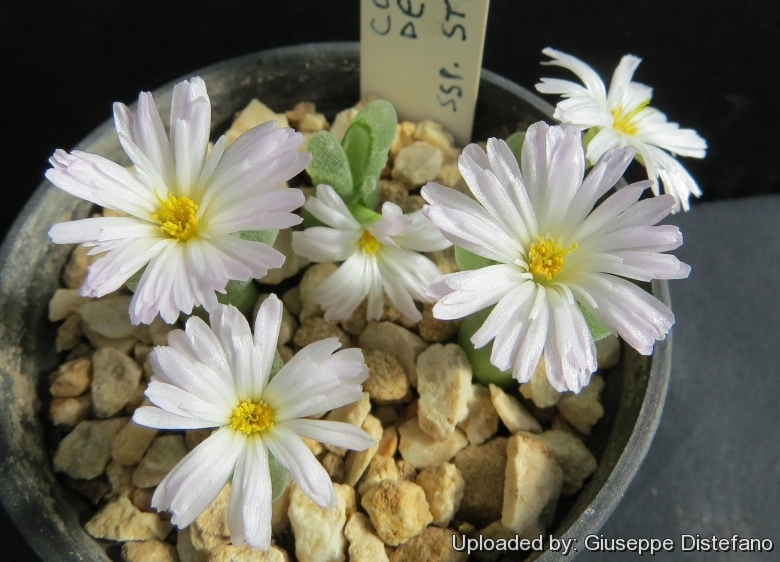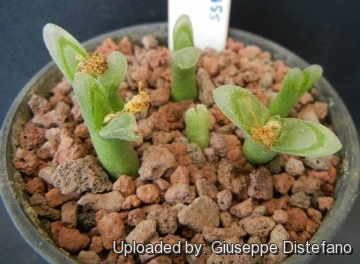
Conophytum devium subs. stiriferum Photo by: Giuseppe Distefano
Origin and Habitat: Namaqualand, Northern Cape, South Africa. C. devium ssp stiriferum occurs to the northeast of C. devium ssp. devium.
Altitude: Up to 1200 metres above sea level.
Habitat and ecology:* Grows on quartz. The small heads tend to be buried in quartz grit and be almost invisible if not in flower.
Synonyms:
See all synonyms of Conophytum devium
Description: Conophytum deviumSN|27246]]SN|27246]] ssp stiriferum is a small cryptic species distinguished by lobes of leaves divergent with apices often conical, appearing hairy or "frosted".
Leaves: to 20 mm 1, divergent often, with an obviously pustulate inner surface and with notched margins, apices often conical, surface covered in long thick icicle-like papillae, unique in the section.
Flowers: Petals pink.
Subspecies, varieties, forms and cultivars of plants belonging to the Conophytum devium group
- Conophytum devium G.D.Rowley: Lobes of leaves pressed together, apices truncate to convex, surface smooth. Distribution: Namaqualand, Northern Cape (South-west of C. devium ssp. stiriferum).
 Conophytum devium subs. stiriferum S.A.Hammer & Barnhill: Lobes of leaves divergent, apices often conical, surface appearing hairy or "frosted". Distribution: Namaqualand, Northern Cape (northeast of C. devium ssp. devium).
Conophytum devium subs. stiriferum S.A.Hammer & Barnhill: Lobes of leaves divergent, apices often conical, surface appearing hairy or "frosted". Distribution: Namaqualand, Northern Cape (northeast of C. devium ssp. devium).
Bibliography: Major references and further lectures
1) Bradleya 15: 42-47 1997
2) Heidrun E.K. Hartmann “Illustrated Handbook of Succulent Plants: Aizoaceae A-E” Springer, 2002
3) Hammer, S. “The Genus Conophytum - A Conograph.” Succulent Plant Publications, Pretoria. 1993
4) Hammer, S. “Dumpling and His Wife: New Views of the Genus Conophytum.” East Anglia Engraving Creative Colour Ltd, Norwich, England. 2002
 Conophytum devium subs. stiriferum Photo by: Giuseppe Distefano
Conophytum devium subs. stiriferum Photo by: Giuseppe DistefanoSend a photo of this plant.The gallery now contains thousands of pictures, however it is possible to do even more. We are, of course, seeking photos of species not yet shown in the gallery but not only that, we are also looking for better pictures than those already present.
Read More... Cultivation and Propagation: The Conophytums belonging to the Ophthalmophyllum group are some of the world's most fascinating plants and are sought by the collector of succulent plants. They grow on winter rain and heads for summer dormancy. They are notoriously difficult to grow because they rot very easily. Paying attention to the particular growing requirement of Ophthalmophyllum is especially important. If you provide the Ophthalmophyllum with the right conditions, they will reward you with their unique shape, size, colour and a proliferation of blooms in autumn. However, Ophthalmophyllum are tricky plants that are very particular about their growing conditions and require the right maintenance in order to keep happy. But don't be afraid even the best growers have plants that mysteriously dry up, or leave during the night. While Ophthalmophyllum are picky about their care, if you are patient and remember the basics, your efforts will be rewarded. Being small plants, a representative collection can be grown on a patio table, a sunny windowsill or a shelf in the greenhouse.
The growing season in northern hemisphere is from September to March.
Soil: It grows best in sandy-gritty soil and requires good drainage as it it is prone to root rot. It can grows outdoor in sunny, dry, rock crevices (protection against winter wet is required) It can also be cultivated in alpine house, in poor, drained soil.
Repotting: Repotting every year is not recommended. They may stay in the same pot for many years. Plants grown in larger containers have frequently relatively poor flowers. They might improve when the plants are given their own, small individual pots.
Fertilization: Feed it once during the growing season with a fertilizer specifically formulated for cactus and succulents (poor in nitrogen), including all micro nutrients and trace elements diluted to ½ the strength recommended on the label. It thrives in poor soils and need a limited supplies of fertilizer to avoid the plants developing excess vegetation, which is easily attacked by fungal diseases.
Watering: The Ophthalmophyllum thrive in dry and desert regions and are able to stand extended periods of drought and require careful watering. Water minimally in summer, (only occasional misting), water more abundantly after the previous year's leaves have dried up when they are growing in the autumn and spring, but let the soil dry between soaking. Requires little water otherwise its epidermis breaks (resulting in unsightly scars). If grown in a container, bottom watering by immersing the container is recommended. Ensure a very good ventilation.
Light: It enjoy some shade (avoid direct sun as it grows wild among rocks and under the shade of other plants) and in summer it need to be kept in a cool area.
Hardiness: It prefer a very bright situation and require a minimum temperature 5°C (But will take a light frost and is hardy down to -7° C for short periods if it is in dry soil). USDA zones 9A – 11.
Uses: Container, rock garden.
Pests and diseases: It is vulnerable to mealybugs and rarely scale.
Propagation: It can be reproduced both by seed in autumn or (or rarely) cuttings. Take the cutting from a grown-up mother plant. Each cutting must contain one or more heads along with a fraction of root and permit to dry out a couple of days, lay it on the soil and insert the stem end partially into the soil. Try to keep the cutting somewhat upright so that the roots are able to grow downward. It is relatively difficult to root Ophthalmophyllum from cuttings and generally pointless as well, so quick are they from seed.
Your Photos

by Giuseppe Distefano












